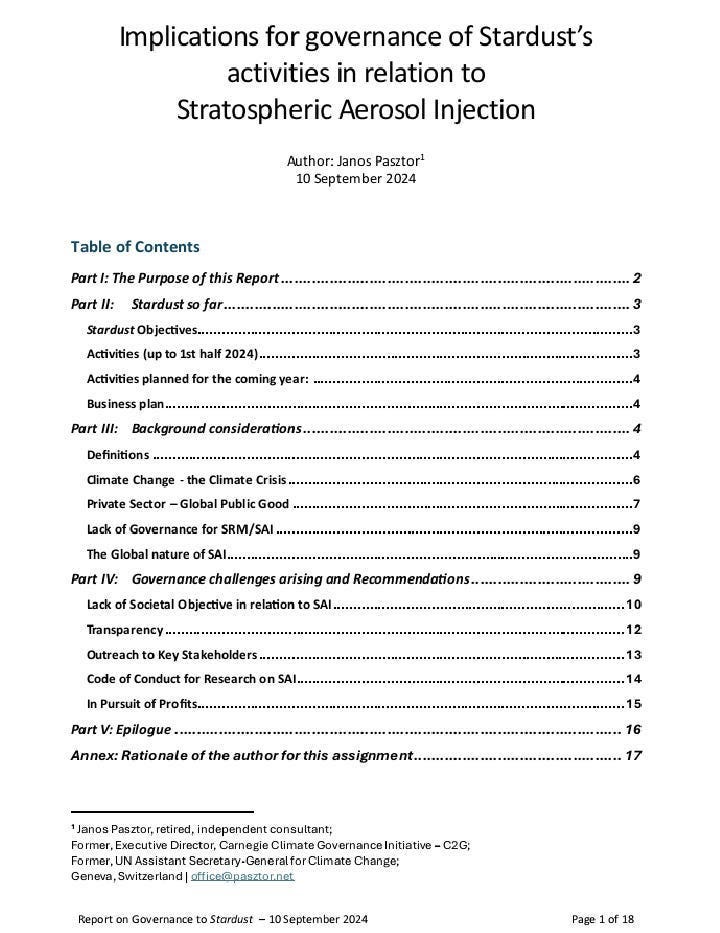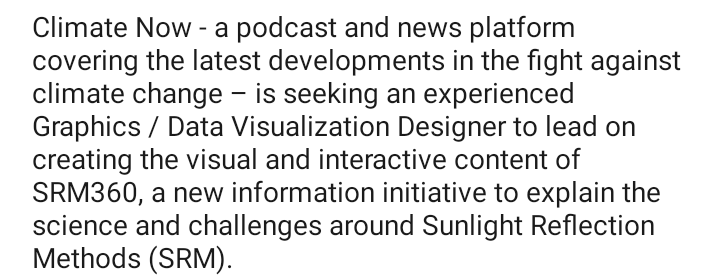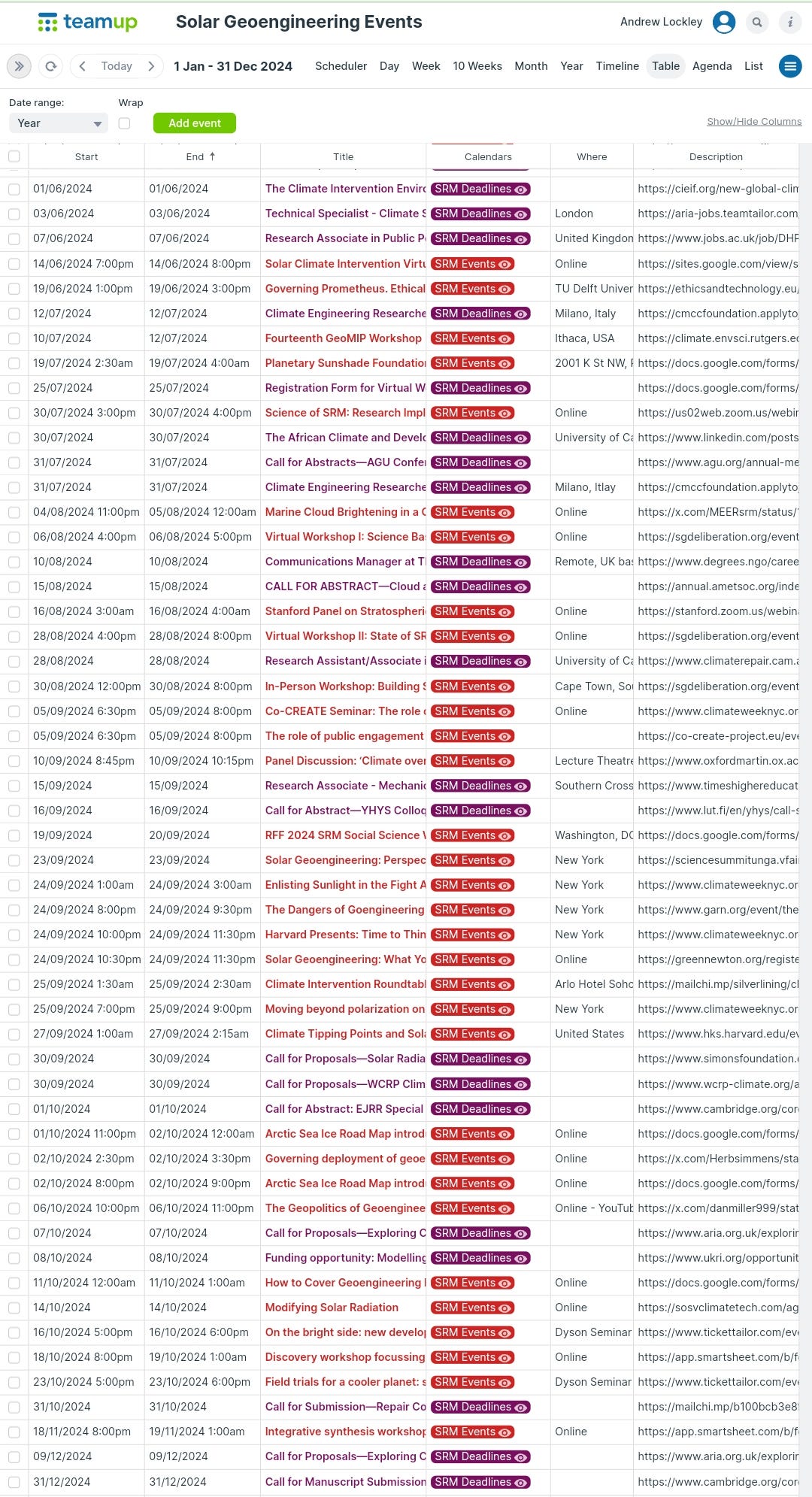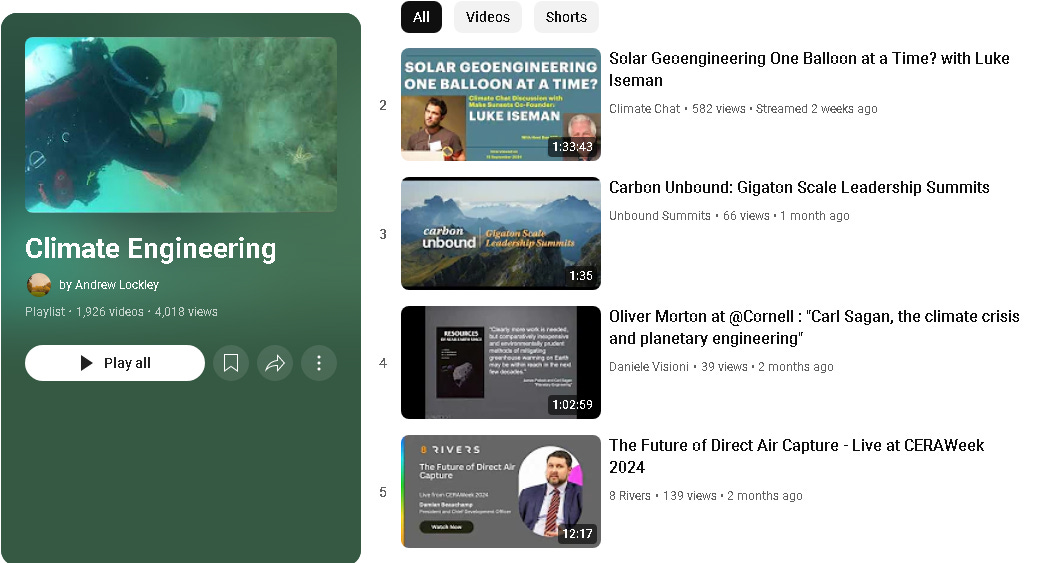The Solar Geoengineering Updates Newsletter (September'2024)
Welcome to the Solar Geoengineering Updates Newsletter, a monthly newsletter that updates you on the developments of everything SRM-related.
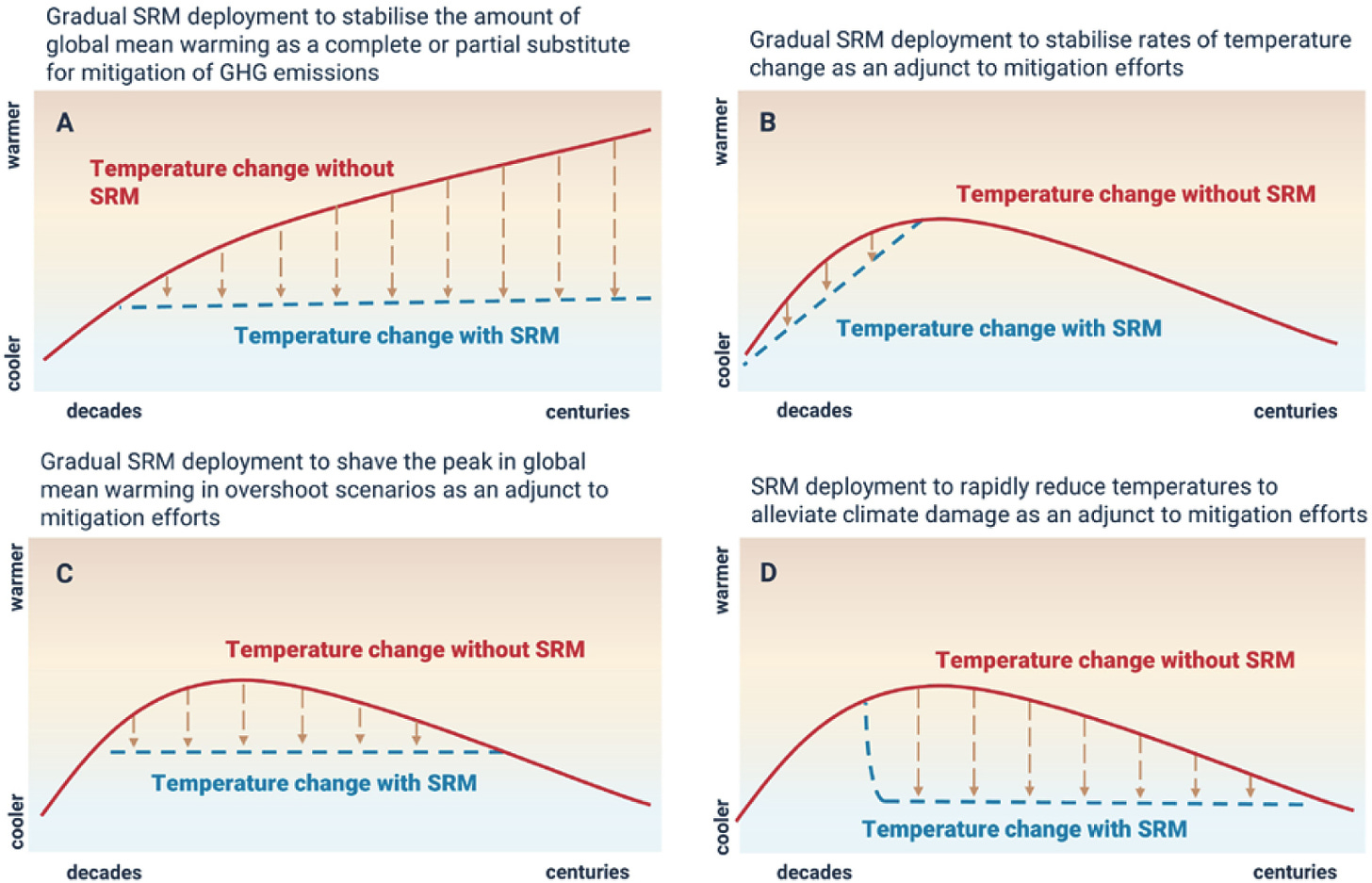
TABLE OF CONTENTS
1. Deadlines
2. Research Papers
3. Web Posts
4. Theses
5. Reports
6. Book Chapter
7. Job Opportunities
8. Upcoming Events
9. Podcasts
10. YouTube Videos
Note: Click on the headings listed in the table of contents above to easily navigate to the sections you're interested in.
DEADLINES
(NEW) Call for Proposals—Exploring Climate Cooling | Deadline to submit concept paper by 07 October 2024 | Full Proposal deadline is 09 December 2024
Funding opportunity: Modelling environmental responses to solar radiation management by Natural Environment Research Council (NERC) | Deadline to apply: 08 October 2024
Call for Submission—Repair Conference 2025 by Centre for Climate Repair | Deadline: 31 October 2024
Applications for presentations and posters are required in the following areas:
-Stratospheric Aerosol Injection
-Marine Cloud Brightening
-Seabed Curtains
-Sea Ice Thickening
-Space Sun Shades
-Other Arctic Repair Topics (e.g. glacier drainage, land surface albedo enhancement, cirrus cloud thinning, ocean foaming etc.)
(NEW) NOAA request for comments on potential solar radiation modification research regulation | Deadline 19 November 2024
Submit your recent research on Solar Radiation Management to new ES: Atmospheres collection | Deadline: 31 January 2025
Call for Proposals-Solar Radiation Management | Deadline to apply: 27 February 2025
RESEARCH PAPERS
Regional impacts of solar radiation modification on surface temperature and precipitation in Mainland Southeast Asia and the adjacent oceans
Narenpitak, P., Kongkulsiri, S., Tomkratoke, S., & Sirisup, S. (2024). Regional impacts of solar radiation modification on surface temperature and precipitation in Mainland Southeast Asia and the adjacent oceans. Scientific Reports, 14(1), 1-17.
Synopsis: This study evaluates the regional impacts of Solar Radiation Modification (SRM) on temperature and precipitation in Southeast Asia. Using data from GeoMIP6, three SRM methods—G6Sulfur, G6Solar, and G1ext—were compared. Findings show that while SRM can reduce surface warming, its effects on precipitation are complex. G6Solar and G1ext reduce overall precipitation, while G6Sulfur may cause further drying in tropical areas due to stratospheric warming from sulfate aerosols.
Change in negative emission burden between an overshoot versus peak-shaved Stratospheric Aerosol Injections pathway
Baur, S., Sanderson, B. M., Séférian, R., & Terray, L. (2024). Change in negative emission burden between an overshoot versus peak-shaved Stratospheric Aerosol Injections pathway. EGUsphere, 2024, 1-22.
Synopsis: This research investigates Stratospheric Aerosol Injection (SAI) geoengineering's impact on atmospheric carbon removal. SAI is explored as a temporary solution to buy time for conventional climate strategies by reducing global warming. Findings show that while early SAI increases carbon uptake, supporting prior studies, later stages diminish this benefit, complicating phase-out. The study highlights uncertainties in the long-term carbon impact of SAI.
Africa's Climate Response to Marine Cloud Brightening Strategies Is Highly Sensitive to Deployment Region
Odoulami, R. C., Hirasawa, H., Kouadio, K., Patel, T. D., Quagraine, K. A., Pinto, I., ... & New, M. G. (2024). Africa's climate response to Marine Cloud Brightening strategies is highly sensitive to deployment region. Journal of Geophysical Research: Atmospheres, 129(17), e2024JD041070.
Synopsis: The study examines Marine Cloud Brightening (MCB) as a solar intervention method to reduce climate risks by enhancing cloud reflectivity. Using climate model simulations, it assesses MCB's effects on Africa. Results show that MCB over the Southeast Pacific (MCBSEP) produces the strongest cooling and increased rainfall, particularly benefiting West Africa. Other regions show weaker effects, with some causing residual warming. This highlights the sensitivity of MCB's climate impact to deployment location.
An investigation of the relationship between tropical monsoon precipitation changes and stratospheric sulfate aerosol optical depth
Xavier, A., Bala, G., Roose, S., & Kh, U. (2024). An investigation of the relationship between tropical monsoon precipitation changes and stratospheric sulfate aerosol optical depth. Oxford Open Climate Change, 4(1), kgae016.
Synopsis: The study investigates Stratospheric Aerosol Geoengineering (SAG) and its potential impact on tropical monsoon precipitation. Using climate model simulations, it quantifies the sensitivity of monsoon rainfall to global and interhemispheric aerosol distributions. Findings show that increased aerosol optical depth significantly reduces northern hemisphere monsoon precipitation. This research provides a simplified framework to assess how external forcing, like SAG, influences tropical monsoons.
Potential effects of climate change and solar radiation modification on renewable energy resources
Kumler, A., Kravitz, B., Draxl, C., Vimmerstedt, L., Benton, B., Lundquist, J. K., ... & Tao, L. (2025). Potential effects of climate change and solar radiation modification on renewable energy resources. Renewable and Sustainable Energy Reviews, 207, 114934.
Synopsis: This research reviews the combined effects of climate change and solar radiation modification (SRM) on renewable energy generation, a key climate mitigation strategy. Focusing on wind, solar, biomass, and hydropower, the research highlights how SRM, particularly stratospheric aerosol injection, may impact renewable energy in the U.S. and globally. It addresses research challenges, potential impacts on renewables, and discusses implications for SRM governance and policy, informing future decision-makers.
Designing a scenario of unilateral climate intervention—Preprint
Keys, P. W., & Bell, C. M. (2024). Designing a scenario of unilateral climate intervention.
Synopsis: The study explores the potential for unilateral climate intervention, specifically stratospheric aerosol injection (SAI), in response to inadequate multilateral climate initiatives. SAI involves dispersing reflective particles in the stratosphere to reduce solar energy reaching Earth. The research identifies characteristics of states likely to initiate SAI without international consensus, focusing on capacity, motivation, sustainability, and resilience to global condemnation. Findings suggest states around the Arabian Sea are most likely candidates. This geopolitical scenario can inform simulations of plausible climate interventions.
Future Seasonal Surface Temperature Predictability with and without ARISE-Stratospheric Aerosol Injection-1.5
Mayer, K. J., Barnes, E. A., & Hurrell, J. W. (2024). Future Seasonal Surface Temperature Predictability with and without ARISE-Stratospheric Aerosol Injection-1.5. Authorea Preprints.
Synopsis: This study explores the potential impacts of Stratospheric Aerosol Injection (SAI) on future climate predictability beyond surface temperature. Using ARISE-SAI-1.5 simulations, researchers analyze seasonal surface temperature predictability under SSP2-4.5, both with and without SAI. The findings reveal significant changes in predictability during boreal summer and winter. In particular, during boreal winter, SAI reduces some increases in future predictability, especially in regions affected by ENSO teleconnections, highlighting its role in modulating midlatitude variability.
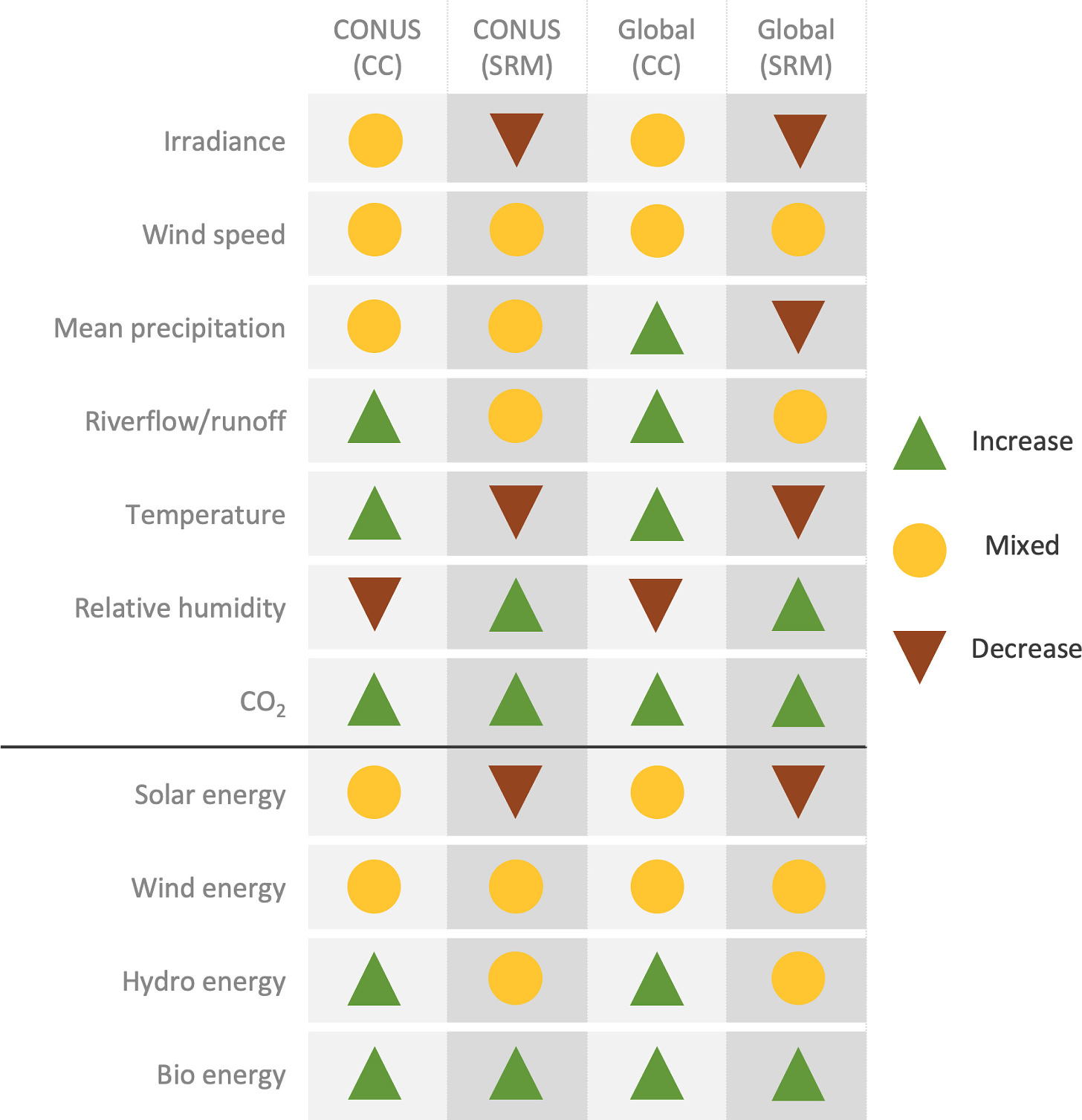
WEB POSTS
Is This Climate Tech Start-Up Going Rogue? Make Sunsets' sulfur dioxide strategy has academics and NGOs fuming (IEEE Spectrum)
Geoengineering is worth the risk — provided we regulate it properly (Financial Times)
Cloud Brightening Over Oceans May Stave off Climate Change, but With Risk (Goodmen Project)
UNSC policy brief: the security implications of solar geo-engineering (Medium)
This climate change fix could save the world — or doom it (USA Today)
Cloud Brightening Over Oceans May Stave off Climate Change, but With Risk (Good Men Project)
Opportunities and Risks: Solar Geoengineering Scenarios for Climate Change Mitigation by 2050 (Politics_DZ)
U.K. to Fund ‘Small-Scale’ Outdoor Geoengineering Tests (New York Times)
American scientists are trying to deflect sunlight back to space to help cool Earth (Google)
Silicon Valley startup's rogue effort to cool planet met with controversy (CBS News)
Security Implications of Climate Change and Climate Interventions (ICFG)
Will We Be Ready? Geoengineering Policy Lags Far Behind Pace of Climate Change (Good Men Project)
A Note On Joining The Oversight Committee for ARIA program on Exploring Climate Cooling Options (DSG)
The UK is building an alarm system for climate tipping points (MIT Technology Review)
Meeting policymakers where they’re at (Medium)
Can we engineer our way out of the climate crisis? Scientists hope to find out (Phys.org)
Comment on Buying Time by David Gelles, New York Times, 1st August 2024 (David Keith)
How to Cool the World Without Blocking the Sun (The Atlantic)
The startup using balloons to cool the planet (Freethink)
Conspiracy Theorists and Vaccine Skeptics Have a New Target: Geoengineering (The NewYork Times)
Silicon Valley Renegades Pollute the Sky to Save the Planet (The New York Times)
India team explores the impact of SRM aerosol injection altitude on precipitation (The Degrees Initiative)
As Earth’s Climate Unravels, More Scientists Are Ready to Test Geoengineering (Scientific American)
Plan to refreeze Arctic sea ice shows promise in first tests (New Scientist)
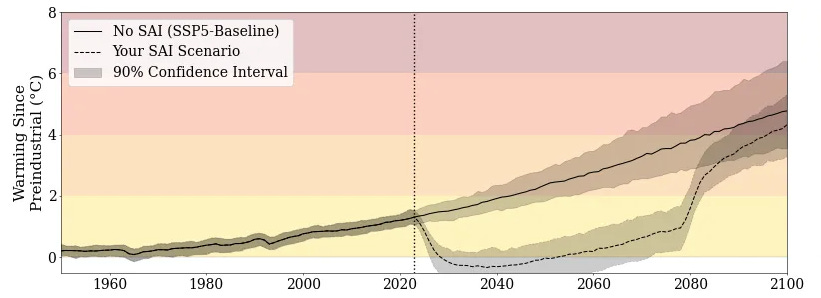
THESES
Design of a Solar Sailing Precursor Mission and Spacecraft to L1 for Global Warming Mitigation
Wilk, L. (2024). Design of a Solar Sailing Precursor Mission and Spacecraft to L1 for Global Warming Mitigation.
Emulating SAI Scenarios in CESM2 and the Effects on the Southern Hemisphere Large-Scale Atmospheric Circulation
Lingbeek, S. (2024). Emulating SAI Scenarios in CESM2 and the Effects on the Southern Hemisphere Large-Scale Atmospheric Circulation (Master's thesis).
The disappearance of ship tracks – on the impact of sulfur reduction in marine fuel on the climate
Mirčetić, N. (2024). The disappearance of ship tracks–On the impact of sulfur reduction in marine fuel on the climate (Doctoral dissertation, Technische Universität Wien).
REPORTS
Implications for governance of Stardust’s activities in relation to Stratospheric Aerosol Injection— A report by Janos Pasztor
BOOK CHAPTER
A Fate Worse Than Warming? Stratospheric Aerosol Injection and Catastrophic Risk
JOB OPPORTUNITIES
Data Visualization Designer at Climate Now | New York, United States
Opportunity for Postdoctoral Researchers at the Climate Systems Engineering initiative at UChicago
"Solar geoengineering, particularly stratospheric aerosol injection (SAI), is being studied as a potential last resort to prevent global warming from exceeding critical climate tipping points. The feasibility, benefits, and risks of these methods depend largely on the physical and chemical properties of the injected aerosols. I am interested in working with a postdoctoral researcher to combine laboratory experiments and process modeling to provide physics-informed insights into three key areas of SAI: (1) evolution of aerosol size distribution and chemical composition for existing and new SAI methods; (2) impact of SAI aerosols on stratospheric ozone depletion; (3) impact of SAI aerosols on tropospheric aerosol-cloud interactions."
Conference Organiser at The Degrees Initiative | Cape Town, South Africa
"The Degrees Initiative is a UK-based NGO that builds the capacity of developing countries to evaluate solar radiation management geoengineering (SRM), a controversial proposal for reducing some impacts of climate change by reflecting sunlight away from the Earth. Degrees is neutral on whether SRM should ever be used, but we believe that developing countries should be empowered to conduct their own research and play a central role in SRM discussions."
UPCOMING EVENTS
(NEW) The Geopolitics of Geoengineering | 06 October 2024 | Online
(NEW) How to Cover Geoengineering by Mongabay | 10 October 2024 | Online
Modifying Solar Radiation | 14 October 2024 | Online
Discovery workshop focussing on atmospheric science (SRM) | 18 October 2024 | Online
Integrative synthesis workshop focusing on identifying gaps in current governance & ethics | 18 November 2024 | Online
(NEW) Climate Repair Seminar Series - Autumn 2024
1: On the bright side: new developments in Marine Cloud Brightening technology | 16 October 2024
2: Field trials for a cooler planet: sea, sky and ice | 23 October 2024
3: Ethics and Governance (title TBA) | 06 November 2024
4: Good COP, Bad COP: a post-COP29 assessment | 27 November 2024
2025 Solar Radiation Management Annual Meeting by Simons Foundation | 24-25 April 2025 | New York
The 2025 Degrees Global Forum | 12-16 May 2025 | Cape Town, South Africa
Artic Repair Conference 2025 by University of Cambridge & Center for Climate Repair | 26-28 June 2025 | Cambridge UK
ge UK
GUIDELINES:
Sync selected events to your default calendar in these simple steps:
1) Click on the event you want to sync.
2) Tap the menu icon (three vertical lines) at the top left.
3) Choose 'Share.'
4) Pick your default calendar.
5) Save the event.
Sync the entire Teamup Calendar to your default calendar with these simple steps:
1) Tap the menu icon (three vertical lines) at the top right.
2) Choose 'Preferences.'
3) Click 'iCalendar Feeds.'
4) Copy the URL shown for 'Solar Geoengineering Events / SRM Deadlines.'’
5) Paste the URL into your default calendar settings (Open Google Calendar in your web browser if you are using Gcal).
6) Click 'Subscribe' or 'Add Calendar.'
For more detailed instructions, visit: https://calendar.teamup.com/kb/subscribe-to-teamup-icalendar-feeds/
You can directly sync all Solar Geoengineering events to your default calendars by pressing the link below:
PODCASTS
Near term Arctic SRM - Wake Smith | Reviewer 2 does geoengineering
"What would a mid-century polar geoengineering program look like? What airports and aircraft would be needed - and at what cost? Wake Smith answers all these questions."
Lawfare Daily: Duncan McLaren on the Opportunity Costs of Geoengineering | The Lawfare Podcast
"Duncan McLaren, Climate Intervention Fellow in Environmental Law and Policy at UCLA, joins Kevin Frazier, a Tarbell Fellow at Lawfare, to discuss geoengineering in light of a recent New York Times article detailing prior efforts to conduct climate interventions, namely the SCoPEx project. This conversation explores the history of geoengineering, different geoengineering techniques, and the opportunity costs associated with further research in the field."
The case for Arctic geoengineering; world’s oldest cheese | New Scientist Podcast
"Could we re-freeze the Arctic… and should we? The Arctic is losing ice at an alarming rate and it’s too late to save it by cutting emissions alone. Geoengineering may be our only hope. A company called Real Ice has successfully tested a plan to artificially keep the region cold - but what are the consequences and will it work on the scale we need?"
The Geopolitics of Climate Engineering: A Climate Lifeline or Pandora’s Box? | The World Unpacked
"In the fight against climate change, a controversial new idea is gaining traction: solar geoengineering. Solar geoengineering, or solar radiation modification, is an emerging technology that aims to reflect sunlight back into space to cool planet Earth. In a world that is struggling to bring about the behavioral and political changes needed to reduce climate change, an innovative tech approach might seem like an alluring silver bullet.
But the reality is not so simple. In this episode, Sophia sits down with Cynthia Scharf, a senior fellow at the International Center for Future Generations and former senior strategy director for the Carnegie Climate Governance Initiative. They discuss solar geoengineering's risks and promises, as well as its implications for geopolitics and conflict."
How green is space travel? | BBC Inside Science
"A personal perspective from a remote island on worrying seabird declines, the results of a project to refreeze Arctic sea ice, and why new evidence unearthed about the Falkland Islands suggests it may once have looked very different."
YOUTUBE VIDEOS
Oliver Morton at @Cornell : "Carl Sagan, the climate crisis and planetary engineering" | Daniele Visioni
"Live recording of Oliver Morton (The Economist) talk at Cornell University, as part of the 14th GeoMIP workshop.
Carl Sagan and Jim Pollack wrote together in 1993: "Clearly more work is needed, but comparatively inexpensive and environmentally prudent methods of mitigating greenhouse warming on Earth may be within reach in the next few decades." Sagan always thought
about planetary climates as things which could be engineered, with papers on terraforming Mars and Venus in the 1960s and 1970s; it is a way of thinking which can be traced back to that of Arrhenius and the other early comparative planetologists of the late 19th/early 20th century. Applying it in a straightforward way to the Earth is problematic in ways Sagan may well not have appreciated. But what he wrote with Pollack thirty years ago was arguably true then and seems true now. What are we to make of the possibility?"
Jeroen Oomen and David Keith debate the Solar Geoengineering Non-use Agreement | UnLivable Cultures Pod
"This episode got a little spicy, and is a must listen for anyone who cares about climate change, geoengineering, or collaboration between natural and social scientists."
Bay Area startup implements controversial plan to combat climate change | KPIX | CBS NEWS BAY AREA
"A strategy to cool the planet using Stratospheric Aerosol Injection (SAI) is being tested in the field in the South Bay. Molly McCrea and Anne Makovec report."
Solar Geoengineering One Balloon at a Time? with Luke Iseman | Climate Chat
“In this Climate Chat episode, we talk with Make Sunsets co-founder Luke Iseman about his approach to "cooling the Earth" by launching balloons into the stratosphere with tiny amounts of sulfur in them. While purposefully putting sulfur into the stratosphere at large scale (called solar geoengineering or solar radiation management (SRM)) is proposed as way to offset global warming, many in the SRM community are opposed to Make Sunsets' "rouge" approach.”
Episode 632 SAI or Why Not | ToSaveTheWorld
“Ye Tao is the founder of MEER, an organization that promotes the potential use of mirrors on land to reflect heat back into space. John Nissen and Herb Simmens are both leaders of HPAC, the Healthy Planet Action Coalition, which considers the possible effects of various proposals for cooling the planet -- especially the Arctic.”
Solar Climate Intervention Virtual Symposium 12 (Dr. Ye Tao & Linus Boselius) | Solar Climate Intervention Talks
“Solar Climate Intervention Virtual Symposium 12 Dr. Ye Tao (Mirrors for Earth's Energy Rebalancing) : "From Geo-Experiments to Geoengineering—the Journey Ahead for Energy Rebalancing at the Earth's Surface." Linus Boselius (University College London, UK) : "Peak Shaving with Solar Radiation Management Would Shorten Global Temperature Overshoot"
Which aspects of Solar Radiation Modification intrigue or concern young people the most? | SRM Youth Watch
“Join SRM Youth Watch as we reflect on last year's journey at New York Climate Week, where we officially launched and connected with brilliant young minds from around the world. This year marks a truly historic moment for future generations with the Summit for the Future taking place from the 20th to the 23rd of September at the 79th United Nations General Assembly. During this time, Heads of State and Government will gather at the United Nations Headquarters to forge a new international consensus on how we can deliver a better present and safeguard the future.”
Solar Geoengineering: What You Need to Know | GBH Forum Network
“The alarming acceleration of global warming is a grave threat to all forms of life. The only viable solution is the reduction and removal of the excess greenhouse gases produced chiefly by fossil fuels. This requires immediate transition to renewable energy, combined with removal of atmospheric CO2. But there is a move to delay that transition by means of solar geoengineering. This approach involves the release of chemical particles high in the atmosphere that will shade the Sun. It does not eliminate the CO2 buildup. Solar geoengineering introduces serious risks that must be explained by responsible scientists.”
The Geopolitics of Climate Engineering: A Climate Lifeline or Pandora’s Box? | Carnegie Endowment
“The Carnegie Endowment for International Peace generates strategic ideas and independent analysis, supports diplomacy, and trains the next generation of international scholar-practitioners to help countries and institutions take on the most difficult global problems and advance peace.”
Loann Marquant: Interview with SRM Youth Watch | SRM Youth Watch
“Loann Marquant got involved in environmental affairs and international relations over the past few years through his engineering studies, as president of his school's geopolitics association and later on through professional experiences at the European Union Delegation to the UN in New York and at the French Mission to the UN in Geneva. More recently, he became a Youth Climate Voice from the Carnegie Climate Governance Initiative and took part in trainings and international events around the topic of SRM. This year, he started a master's degree in public policy at Harvard Kennedy School.”





